

-

Shoot (1971)
Chris Burden
Chris Burden flirted with danger, even death, to experience what most wish to avoid in a series of iconic performances he began while still a graduate student at the University of California, Irvine (UCI). During this same time students in the UCI Master of Fine Arts program organized and ran the F Space Gallery in an industrial building in nearby Santa Ana. The space is best known for Burden’s infamous performance, Shoot, in which a friend shot the artist in his left arm with a .22 rifle on November 19, 1971, while the guests in the gallery watched the “crime” take place. Although Burden had intended for the bullet to only to graze his arm, it penetrated his flesh. Burden had been thinking about what it would be like to be shot ever since the Kent State University shootings in 1970 when four students were killed. Shoot foregrounds what would become Burden’s ongoing interests in risk-oriented performances that explore the dynamics of power, issues of spectatorship, challenges to the physical body and the redefinition of the parameters of the artist and work of art.
Color Photograph 16 x 20 in
University of California, Berkeley Art Museum and Pacific Film Archive; gift of the Naify Family At 7:45 p.m. I was shot in the left arm by a friend. The bullet was a copper jacket .22 long rifle. My friend was standing about fifteen feet from me -

First Supper (After a Major Riot) (1974)
Asco
Asco, founded by Harry Gamboa Jr., Willie Herrón III, Glugio Gronk Nicandro (“Gronk”) and Patssi Valdez, was an East Los Angeles-based collective active from the early 1970s to the mid 1980s. Named after the Spanish word for “nausea,” Asco adopted the strategies of political protest in their conceptual, multi-disciplinary art that included fotonovelas, mail art, photographs, happenings, media hoaxes, experimental poetry and public interventions. Asco’s Dada-like antics were inspired by the Chicano civil rights movement, anti-war activism, feminism, and the post-Stonewall gay liberation of the era. First Supper (After a Major Riot) (1974) is Harry Gamboa’s photograph of a performance that Asco did on a traffic island on Whittier Boulevard--the same street where a violent riot occurred between Chicano anti-war protestors and the police on January 31, 1971. As Gamboa recalls: “Several hundred young people marched peacefully in protest against ongoing police intimidation and brutality in the Chicano community… deputies suddenly began free-firing their weapons many times and scores of wounded people fell to the asphalt while many others scattered for relative safety. At least one individual was killed.” First Supper (After a Major Riot) captures this site-specific public performance that serves as a momento mori of this troubling incident.
Performance documentation, color photograph (l-r: Patssi Valdez, Humberto Sandoval, Willie Herrón III, and Gronk 30 x 40 in
Courtesy of Harry Gamboa, Jr Photo: © 1974 Harry Gamboa, Jr. -

Instant Mural (1974)
Asco
Asco, founded by Harry Gamboa Jr., Willie Herrón III, Glugio Gronk Nicandro (“Gronk”) and Patssi Valdez, was an East Los Angeles-based conceptual art and performance group active from the early 1970s to the mid 1980s. Named after the Spanish word for “nausea,” Asco adopted the strategies of political protest in their conceptual art that moved between media and genres as they produced fotonovelas, mail art, photographs, happenings, media hoaxes, poetry experiments and public interventions. Inspired by the Chicano civil rights movement, anti-war activism, feminism, and the post-Stonewall gay liberation of that era, Asco brought Dada-like antics to Los Angeles. Rejecting the kinds of Chicano murals of that time, Asco reinvented muralism and other tropes of Chicano art with satirical performances such as Instant Mural (1972). Patssi Valdez is seen here in Harry Gamboa’s photograph taped to a wall as a living, human mural character, …” satirizing the typical Chicano painting style and pushing the boundaries of what it might encompass.”
Performance documentation, color photograph (left to right: Patssi Valdez and Gronk) 30 x 40 in
Courtesy of Harry Gamboa, Jr Photo: © 1974 Harry Gamboa, Jr. -
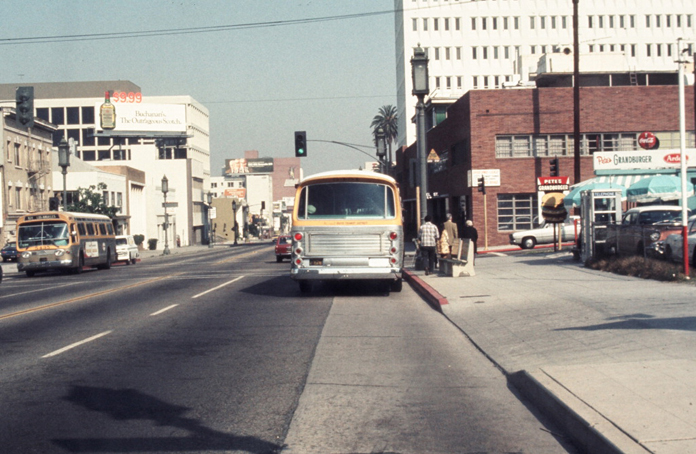
May 1, 1971 (detail) (1971)
Paul McCarthy
Paul McCarthy moved from his native Salt Lake City, Utah, to pursue his B.F.A. at the San Francisco Art Institute and then relocated to Los Angeles to complete his M.F.A. at the University of Southern California. A highly influential professor, he taught in the New Genres area of the UCLA Art Department for more than twenty years. McCarthy has become well-known for his irreverent and provocative video-taped performances, large-scale public sculptures, and multimedia installations that elicit a satirical social critique. After attending art school in the early 1970s, McCarthy decided to stay in Los Angeles where he began to make conceptual photographs and videos. Fascinated by the ubiquitous flow of traffic in the city, May 1, 1971 (1971), is a still of his slide projection of twenty-five photographs all shot from the same fixed position on the street. Related to similar conceptual works by his contemporary Douglas Huebler, McCarthy uses a set system to “map†the flow of traffic in a particular geographic location. This constant everyday phenomenon is imperceptible unless documented over the course of time. This work is an analogue to some of McCarthy's other early conceptual photographs that explore interior or public spaces.
Twenty-five projected slides Courtesy of the artist and Hauser & Wirth
-
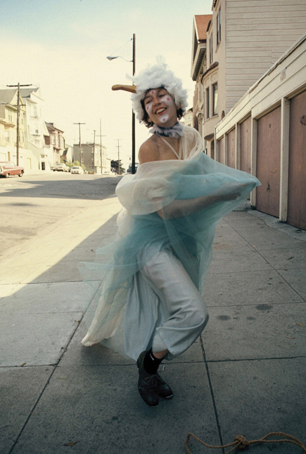
Chicken Dance: The Streets of San Francisco (1972)
Linda Mary Montano
Linda Mary Montano is a seminal figure in contemporary feminist performance art and her work since the mid 1960s has been critical in the development of video by, for, and about women. Attempting to dissolve the boundaries between art and life, Montano continues to actively explore her art/life through shared experience, role adoption, and life altering ceremonies. Her artwork is starkly autobiographical and often concerned with personal and spiritual transformation. Chicken Dance: The Streets of San Francisco was performed in 1972 in nine public spaces throughout the city, including museums, galleries, and iconic sights such as the Golden Gate Bridge and the Conservatory of Flowers in Golden Gate Park. Wearing a blue prom dress, tap shoes, and an elaborate chicken-feather headdress, Montano traipsed around the city pulling a small wagon with a cassette player, often dancing spontaneously. She had adopted the chicken as her personal totem before she arrived in San Francisco because, in their display of extreme concentration (their entire focus is gathering food) and in their nonfunctional wings, chickens reminded her of a Zen parable. Montano sought personal transformation through her performances
Performance documentation, color photograph 11 x 14 in
Courtesy of the artist, Saugerties, New York. Photograph by Mitchell Payne -
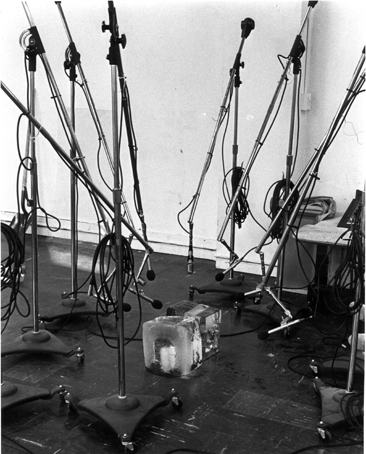
Sound of Ice Melting (1970)
Paul Kos
Paul Kos is a San Francisco-based artist whose early work of the 1970s included installations and videos that often addresses the kinetic properties of natural materials. This included a series of process-oriental sculptural installations such as the Sound of Ice Melting consists of ten state of the art microphones set to record the “sound” of the melting of two twenty-five pound blocks of ice. An absurdist proposition that can be understood in Buddhist terms, Kos’s installation premiered in Sound Sculpture As at the Museum of Conceptual Art (MOCA) in San Francisco, one of the first sound exhibitions anywhere. Kos shared with Arte Povera artists—working at the same time in Italy—an interest in process-oriented sculptural works made up of unconventional, often organic, materials.
installation view from Sound Sculpture As, April 30, 1970, Museum of Conceptual Art, San Francisco; installation with two 25-lb. blocks of ice, eight boom microphone stands, mixer, amplifier, two large speakers, and cables 78 x 240 x 180 in
Courtesy of the artist and Gallery Paule Anglim, San Francisco -

First Lady (1967-1972)
Martha Rosler
Martha Rosler's works in photomontage, video, photo-text, critical writing, and installation, are astute investigations of social and political topics executed with deadpan wit. Born and raised in Brooklyn, Rosler attended Brooklyn College and first came to California to study art at the University of California at San Diego, where she met faculty and other students also immersed in feminist, environmental, economic, and social issues. In 1967 Rosler began make photomontages devoted to subjects such as the Vietnam War and the objectification of women. In Bringing the War Home (1967–72), she juxtaposed horrific newspaper and magazine photographs of the war with stylish home interiors from architectural and design magazines to critique of American militarism and domestic complacence. This particular photomontage depicts Patricia Nixon, wife of the then-president, dressed in formal attire standing stiffly in a living room. Above the fireplace is a framed image of a gruesome execution scene. In this work the “war†image was drawn not from a newspaper but rather depicts the bullet-ridden Faye Dunaway in the Arthur Penn film of 1967, Bonnie and Clyde—the final violent scene that Penn said was influenced by the daily reports and images of the Vietnam War.
Photomontage 20x24
Courtesy of the artist and Mitchell-Innes & Nash Gallery, New York -

Portable Park II (1970)
Bonnie Sherk
Bonnie Sherk's practice of the 1970s involved performance-based interventions that brought the experience of nature into unexpected locations in both galleries and in the urban environment. Her mission was to bring the experience of nature into the city by way of unexpected interventions. One of the first was Portable Parks I–III, in which she and Howard Levine imported turf, palm trees, picnic tables, and live farm animals to San Francisco streets and elevated freeway ramps and reflected Sherk's interest in animal behavior and ecological systems as microcosms and laboratories. Sherk followed Portable Parks with Sitting Still, in which she sat for approximately one hour in various city locations as a means to subtly change the environment simply by becoming a part of it. In the first, dressed in an evening gown, she rested in an upholstered armchair that floated in the water and garbage from the construction of a freeway interchange. Other locations in the series included the financial district, the Golden Gate Bridge, and the Bank of America plaza. Sitting Still culminated in Public Lunch where, again elegantly attired, the artist dined on a catered meal in an empty cage at the zoo before a large crowd that had assembled to watch the lions and tigers in adjacent cages feed on raw meat.
Performance Documentation
Courtesy of the artist, San Francisco -
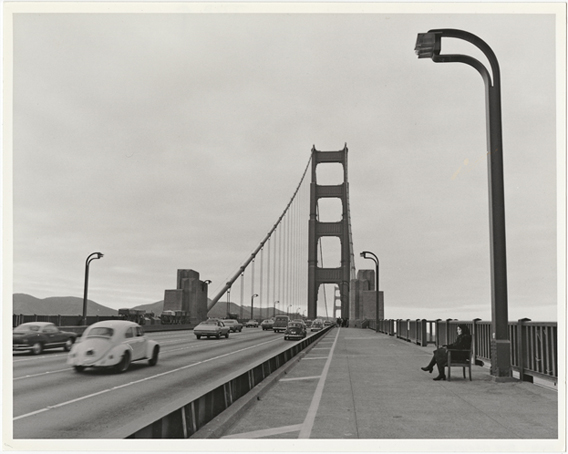
Sitting Still (1971)
Bonnie Sherk
Bonnie Sherk's practice of the 1970s involved performance-based interventions that brought the experience of nature into unexpected locations in both galleries and in the urban environment. Her mission was to bring the experience of nature into the city by way of unexpected interventions. One of the first was Portable Parks I–III, in which she and Howard Levine imported turf, palm trees, picnic tables, and live farm animals to San Francisco streets and elevated freeway ramps and reflected Sherk's interest in animal behavior and ecological systems as microcosms and laboratories. Sherk followed Portable Parks with Sitting Still, in which she sat for approximately one hour in various city locations as a means to subtly change the environment simply by becoming a part of it. In the first, dressed in an evening gown, she rested in an upholstered armchair that floated in the water and garbage from the construction of a freeway interchange. Other locations in the series included the financial district, the Golden Gate Bridge, and the Bank of America plaza. Sitting Still culminated in Public Lunch where, again elegantly attired, the artist dined on a catered meal in an empty cage at the zoo before a large crowd that had assembled to watch the lions and tigers in adjacent cages feed on raw meat.
Performance Documentation
Courtesy of the artist, San Francisco Photo: Robert Campbell/Chamois Moon -
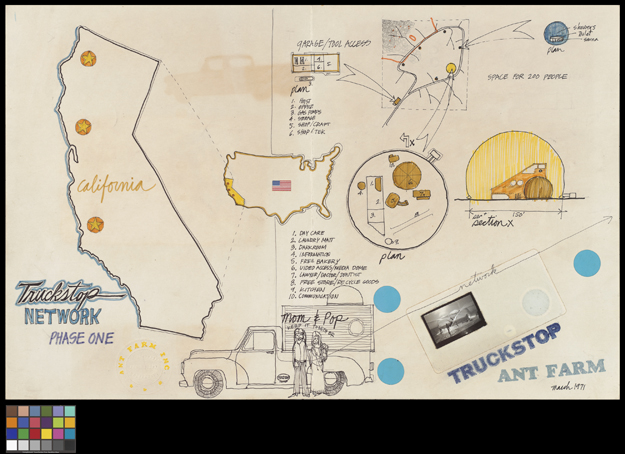
Truck Stop (1971)
Ant Farm
Ant Farm was a radical collective operated from 1968 to 1978 in the San Francisco Bay Area and Houston, Texas. They set out to create an alternative architecture suited to a new, nomadic lifestyle. Inspired by such visionaries as Buckminster Fuller and Paolo Solari, as well as European architecture groups such as Archigram, they developed giant polyethylene inflatable structures, easy and cheap to build and transport and symbolic of their opposition to mainstream Brutalist architecture of the 1960s. In 1970, in their customized Chevrolet media van, they started their Truckstop Network, a rollicking tour of colleges and universities where they unrolled and inflated their ICE-9 inflatable and demonstrated the Eisenhower-era trailer, which contained a kitchen and shower with solar-heated water. These interactive events were closer to happenings than to typical architectural demonstrations.
Drawing with collaged elements: colored felt-tipped pen, stamped ink, India ink, embossing, stickers, and photographs 11 x 17 in
University of California, Berkeley Art Museum and Pacific Film Archive -

Chicken Dance: The Streets of San Francisco (1972)
Linda Mary Montano
Linda Mary Montano is a seminal figure in contemporary feminist performance art and her work since the mid 1960s has been critical in the development of video by, for, and about women. Montano actively explores her art/life through shared experience, role adoption, and life altering ceremonies. Her artwork is starkly autobiographical and often concerned with personal and spiritual transformation. Chicken Dance: The Streets of San Francisco was performed in 1972 in nine public spaces throughout the city. Wearing a blue prom dress, tap shoes, and an elaborate chicken-feather headdress, Montano traipsed around the city pulling a small wagon with a cassette player, often dancing spontaneously. She had adopted the chicken as her personal totem before she arrived in San Francisco because, in their display of extreme concentration (their entire focus is gathering food) and in their nonfunctional wings, chickens reminded her of a Zen parable.
Performance documentation
Courtesy of the artist, Saugerties, New York Photograph by Mitchell Payne -
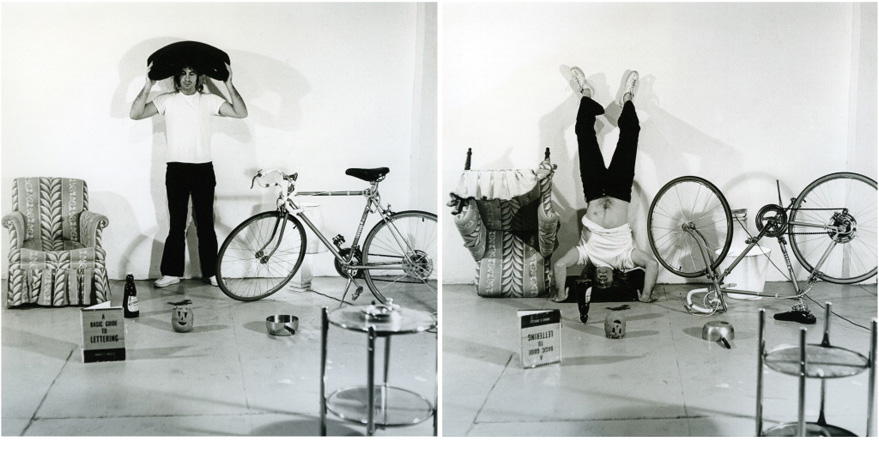
Basic Guide to Lettering (1972)
William Wegman
William Wegman was an early practitioner of Conceptual photography. In a series of black-and-white photographs, his low-tech and comedic approach belies a more serious intent—questioning of photographic veracity and a sly commentary on art making in general. At the same time, Wegman made his now iconic videos. He kept a video camera at the ready in his Los Angeles studio so that he could spontaneously enact short comedic scenes that involved using his own body, simple props, and/or his dog. In these deceptively casual skits, Wegman switches genders or assumes various personae, often a hapless salesman peddling a useless gadget. Puns, objects found around the studio, and, of course, his dog Man Ray, comprise his repertory.
Diptych photograph 11 x 11 in. each; 13 x 22 1/4 in. framed
Courtesy of the artist, New York, and Marc Selwyn Fine Art, Los Angeles -
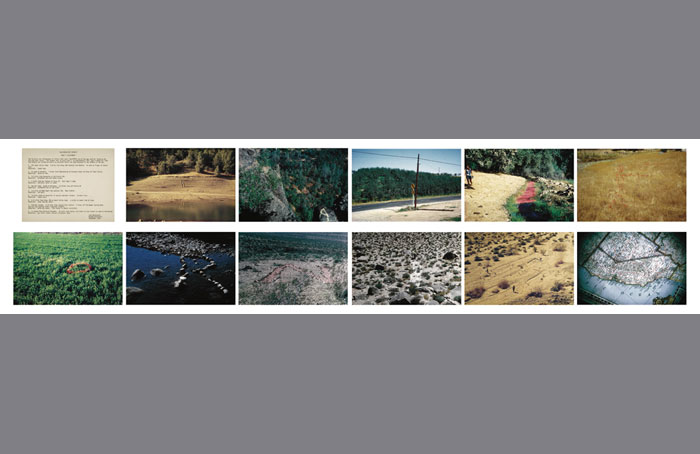
California Map Project Part I: California (1969)
John Baldessari
John Baldessari, born in National City, California, studied art at San Diego State University, Otis Art Institute, Chouinard Art Institute, and University of California, Berkeley. He taught for forty years at the California Institute of the Arts in Valencia and UCLA serving as an important mentor for several generations of young art students. Baldessari’s conceptually oriented work includes artist books, videos, films, billboards, and public projects. His California Map Project (1969) is a series of ten photographs, a map, and a set of coordinates, in which he transposes the letters that spell out California as they appear on a map to their actual locations in the California landscape. Working with jazz musician George Nicolaidis and George’s wife, Judy, Baldessari started in the south part of the state with the “A” in Joshua Tree National Monument and then moved north spelling California backward, ending with the letter “C” on the bank of Shasta Lake. Rendering the letters in pigment, fabric, rocks, yarn, and a telephone pole, each was documented in an aerial photograph. Part earthwork, part conceptual artwork, part performance, Baldessari’s work signals Conceptualism’s tendency to emphasize concept and process over physical objects—to use secondary material/documentation and to follow an absurd idea to its rational conclusion.
Twelve archival ink-jet prints on Dibond (exhibition copy, 2009; original work: color photographs and text) 8 x 22 in. each photograph; 8 1/2 x 11 in. text
Courtesy of the artist and Marian Goodman Gallery
Orange County Museum of Art
State of Mind: New California Art Circa 1970
State of Mind: New California Art Circa 1970, co-organized by Orange County Museum of Art (OCMA) and UC Berkeley Art Museum and Pacific Film Archive (BAM/PFA), is the most comprehensive exhibition to date to focus on Conceptual art and related new genres in both Northern and Southern California during this pivotal period in contemporary art. Featuring more than 150 works of art, the exhibition includes installations, photographs, works on paper, videos and films, artists' books, extensive performance documentation, and other ephemera. Some of the highlights of the exhibition include the important early surveillance installation Being Photographed, Looking Out, Looking In, February 4-20, 1971 by Chris Burden, currently in a private collection and not exhibited since the 1970s; the most comprehensive installation of artifacts, photographs, and the original soundtrack from Allen Ruppersberg's, Al's Grand Hotel (1971); the most complete documentation ever presented in a museum of Bonnie Sherk's street performances Sitting Still Series (1970); and archival photographs from William Wegman's studio, recently discovered at the BAM/PFA and never before seen in California. Other artists featured in State of Mind whose practices deserve greater attention are Gary Beydler, Nancy Buchanan, Adam (the late Paul Cotton), Lowell Darling, Suzanne Lacy, Stephen Laub, Darryl Sapien, Susan Mogul, Ilene Segalove, Fred Londier, and Robert Kinmont.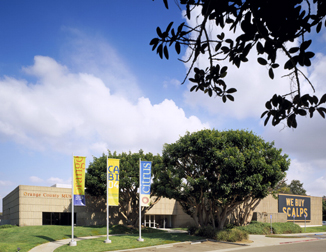
Newport Beach, CA 92660












